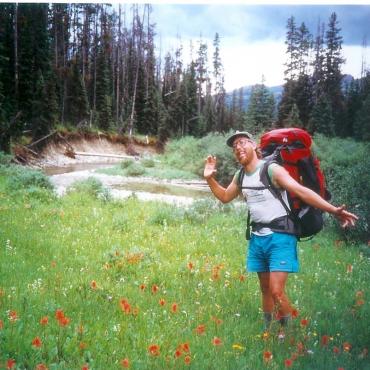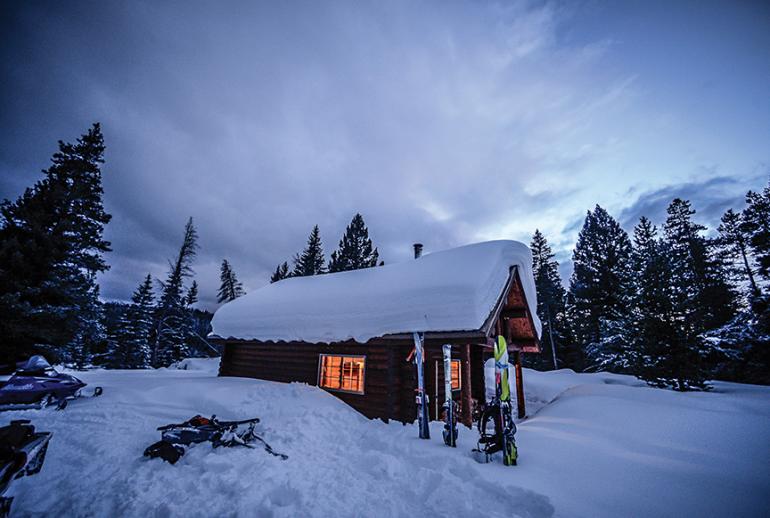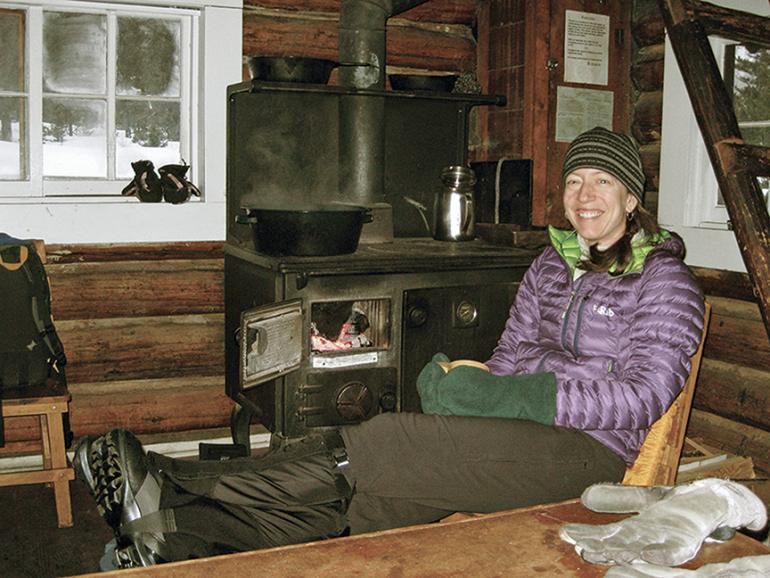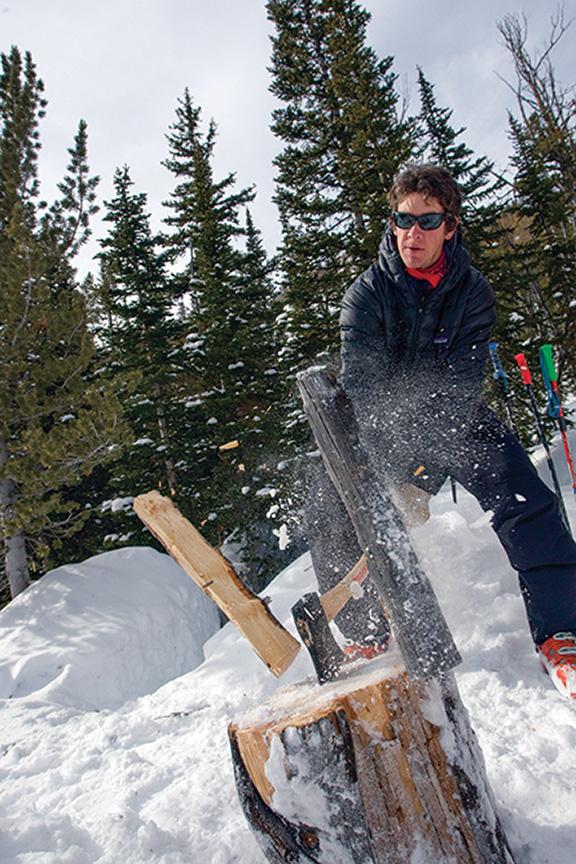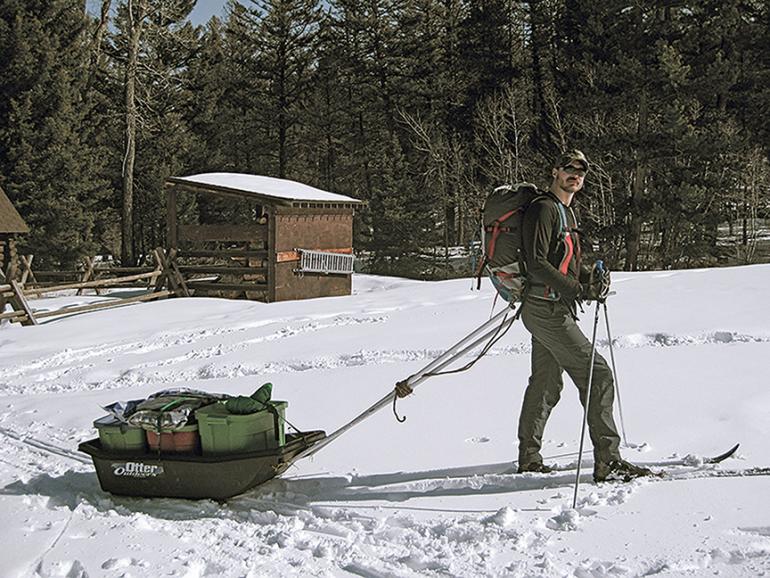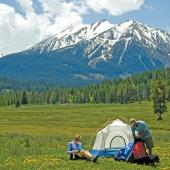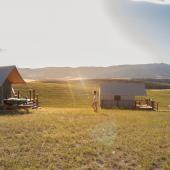Cabins Calling
Retreating to Forest Service getaways.
Picture this: you and your friends gathered around a wooden table, perched on benches padded with your sleeping pads. The table is spread with the feast you have laid out. Steaming pans of hot chow are ready to load onto plates and chilled bottles sit waiting to be poured. Everyone raises a cold brew to toast friends and wild times in the high country. A fire crackles in the woodstove, melting the ice off the windows and sending a deep warmth into your bones. Outside, it’s dumping, piling up an inch an hour, and the wind moans around the eaves of your cozy hideaway. Tomorrow promises the best powder turns of the season, after you break trail through ten inches of fresh.
Where can you find this vision of winter paradise? How about nearly any one of the 26 cabins available to rent on the Custer-Gallatin National Forest. Built mostly as patrol cabins and ranger stations in the early 1900s, these snug little lodges are located all across southwest Montana’s national forests. Maybe you want to use one as a basecamp to warm up in after a backcountry shred session. Could be it’s a buddy’s last week of freedom, and you need to throw him a bacchanalian bachelor bash. Or you just want to get away for a night or two, chill out, and read by the fire in peace and quiet. The ambience and access offered by Forest Service cabins is hard to beat, and they’re pretty cheap as well. For around $45-60 per night, you’ll have the whole place to yourself. Nearly every national forest has rental cabins available, but the Custer-Gallatin has the most. Here’s a sample of some local favorites for winter fun.
Garnet Mountain Lookout
Perched at 8,245 feet on a remote summit, the Garnet Mountain Lookout boasts the finest views of any cabin in the Gallatin Range, with stunning vistas of the nearby Spanish Peaks, the northern Gallatin high country, and, far below, Gallatin Canyon. It has a wrap-around deck and lots of windows. A fire lookout has occupied the summit of Garnet since 1930, but the current structure dates to 1962.
Winter is my favorite time stay in the lookout, and my wife and I have enjoyed two Christmases and two New Years there, either alone or with friends. There’s decent skiing on the summit of Garnet, though the runs are short, but you can ski right from the stairs of the cabin. I can also attest that it’s an awesome place for a bachelor party—there are no neighbors to annoy with your raucous antics. The lookout is accessible by snowmobile, but plan on a long approach if you’re skiing in. Depending on road conditions in Storm Castle Creek, it can be up to ten miles via Rat Lake. The summer trail may be unsafe in winter due to avalanche danger.
Spanish Creek Cabin
Also built in 1934, Spanish Creek Cabin offers super easy drive-up access much of the year, when the road to the trailhead isn’t gated or drifted-in with snow. Access is through Ted Turner’s Flying D Ranch, where you can see hundreds of the bison that Turner runs on his ranch. Abundant wildlife such as moose, owls, and wolves add to the allure of the place. In winter, a 3.5-mile trip on snowmobile, skis, or foot is required to get to Spanish Creek Cabin, and beyond that is great ski or snowshoe adventuring. Choose between the South Fork Spanish Creek trail, Little Hellroaring trail, or Willow Swamp trail. The cabin sleeps four and there’s a firepit outside for late-night revelry.
Window Rock Cabin
Window Rock is one of the closest cabins to Bozeman, accessible by road most of the year now that the Hyalite Canyon Road gets plowed. It was built in 1940 to replace the Hood Meadows Guard Station, which was flooded by Hyalite Reservoir and may actually still exist under the water. For ice climbers in the world-class venue of Hyalite Canyon, Window Rock makes the perfect basecamp, with bunks for four people. It’s an easy hike to the Mummy or Genesis climbing areas, and Nameless Wall is also nearby. Try Twin Falls for a longer day trip to a moderate, full-pitch ice climb. Climb both sides of the falls for a full-day adventure. Most of the climbing areas get used enough to have foot trails beat in, eliminating the need for skis or snowshoes on the approach. However, ski poles are an essential accessory.
How about some AT skiing? Ready to give that splitboard a real workout? Head up Maid of the Mist, accessible from the main fork of Hyalite. Or drive back over the dam to the Blackmore trailhead to access the popular 10,000-foot summit of Mount Blackmore, with awesome moderate ski terrain on Blackmore Bowl or Elephant’s Head.
Porcupine Cabin
Located in a stunning meadow on the west slope of the Crazy Mountains, Porcupine Cabin has room for eight people, making this a great retreat for larger groups like families or a posse of pals. It’s a mile-and-a-half ski or snowshoe to reach the cabin in winter, just far enough to feel remote. It’s easy to drag a loaded sled up the road to the cabin, allowing for more luxuries for your stay.
Porcupine was originally built in 1914 as an unusual two-story building with a porch upstairs and down, and was meant to house forest rangers patrolling for timber poachers, monitoring fires, and keeping an eye on livestock. In 1934, the CCC remodeled it into its current form. The cabin also served as the headquarters for the Shields Ranger District, and now it’s one of the best cabins in the rental fleet. There’s some of the finest sledding you could ever ask for in the meadow behind the cabin, or you can venture out on skis to Elk Creek or up to Bald Ridge and beyond. Surveying for signs of wolverine, I once skied up and over a 9,000-foot ridge into the South Fork of the Shields and all the way back to the cabin in a day, a fabulous tour of Crazy Mountain backcountry.
Battle Ridge
Only 20 miles by road from Bozeman, Battle Ridge cabin (sometimes known as Bottle Ridge) gets heavily used since it’s only a quarter-mile from the road in winter, and accessible by car otherwise. Built by the Emergency Relief Administration, it replaced the dilapidated Ross Peak Guard Station. This one sleeps five and is perfect for a quick getaway or as a basecamp for skiing in the Bridgers. You could even use it as a lodge for a couple of days of skiing at Bridger Bowl if family is in town and you don’t feel like hosting. Plan on bringing a couple of kids’ sleds to make some runs in the meadow below the cabin. Take a ski tour far back into the South Fork of Brackett Creek, where Wolverine Bowl provides epic turn potential in classic Bridger backcountry.
Mill Creek Cabin
This area was once known as the Absaroka National Forest. Located up Mill Creek in the spectacular Absaroka Range, the Mill Creek cabin was built in 1927 as temporary lodging for traveling rangers. This is the only cabin on this list that has electric lights and an electric cooking range, and it also has a back porch and a sweet front porch with a picnic table and chairs. There’s inviting cross-country skiing and snowmobiling up Mill Creek and Wicked Creek. With a sled you can access the steep ski terrain of Arastra Creek, or ski from the cabin to see the frozen wonder of Passage Falls. A high-clearance 4WD vehicle is recommended to reach the cabin. Mill Creek sleeps four.
Things to Consider
Most Forest Service cabins have had all cooking and eating utensils removed due to sanitation concerns, so plan to bring your own cook stove, pots and pans, bowls, plates, mugs, and tableware. The Forest Service stocks the cabins with firewood, and most have propane lanterns (bring a propane canister or two). You’ll usually find a splitting maul and hatchet to prepare firewood. Good protocol requires you to leave the cabin clean and organized, with plenty of split firewood, kindling, and firestarter. For more info and to reserve a cabin, visit recreation.gov.

